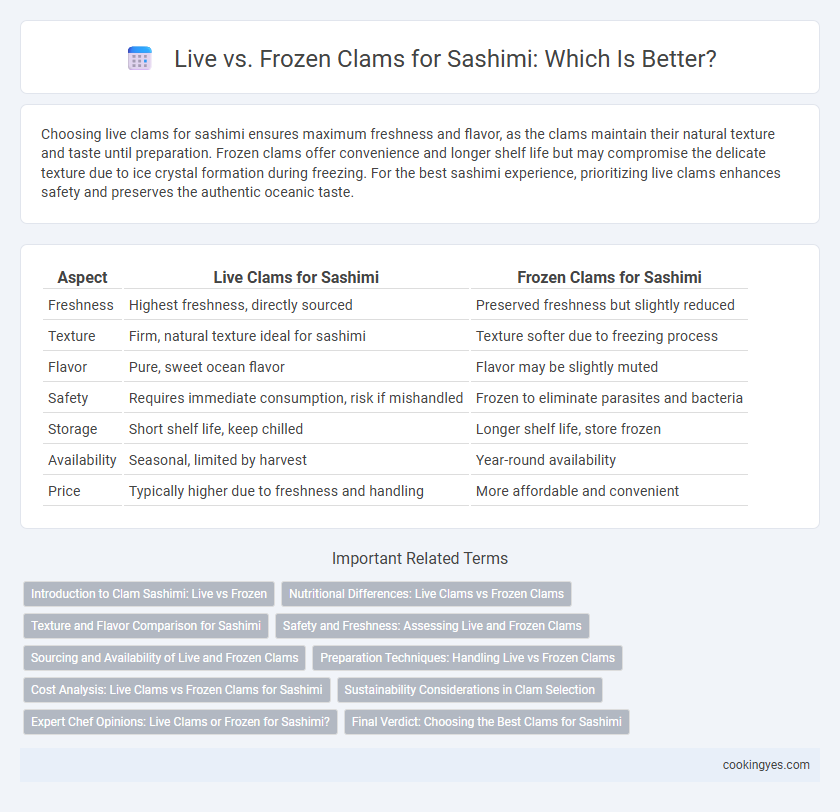Choosing live clams for sashimi ensures maximum freshness and flavor, as the clams maintain their natural texture and taste until preparation. Frozen clams offer convenience and longer shelf life but may compromise the delicate texture due to ice crystal formation during freezing. For the best sashimi experience, prioritizing live clams enhances safety and preserves the authentic oceanic taste.
Table of Comparison
| Aspect | Live Clams for Sashimi | Frozen Clams for Sashimi |
|---|---|---|
| Freshness | Highest freshness, directly sourced | Preserved freshness but slightly reduced |
| Texture | Firm, natural texture ideal for sashimi | Texture softer due to freezing process |
| Flavor | Pure, sweet ocean flavor | Flavor may be slightly muted |
| Safety | Requires immediate consumption, risk if mishandled | Frozen to eliminate parasites and bacteria |
| Storage | Short shelf life, keep chilled | Longer shelf life, store frozen |
| Availability | Seasonal, limited by harvest | Year-round availability |
| Price | Typically higher due to freshness and handling | More affordable and convenient |
Introduction to Clam Sashimi: Live vs Frozen
Clam sashimi offers distinct taste and texture profiles depending on whether it is served live or frozen, with live clam sashimi providing superior freshness and a naturally sweet, briny flavor. Frozen clam sashimi undergoes a quick-freezing process that preserves safety and extends shelf life but may slightly alter the delicate texture and subtle taste. Understanding these differences is crucial for chefs and consumers seeking authentic sashimi experiences and optimal quality.
Nutritional Differences: Live Clams vs Frozen Clams
Live clams retain higher levels of vitamins B12, C, and essential minerals like zinc and selenium compared to frozen clams, which may experience nutrient degradation during freezing and thawing. The freezing process can reduce the bioavailability of omega-3 fatty acids and diminish the fresh flavor profile crucial for sashimi-grade clams. Consuming live clams ensures optimal preservation of antioxidants and enzymes that contribute to both nutritional value and overall health benefits.
Texture and Flavor Comparison for Sashimi
Live clams used for sashimi offer a superior texture, providing a firm yet tender bite that enhances the overall eating experience. Freshness of live clams preserves their natural briny flavor and subtle sweetness more effectively than frozen counterparts. Frozen clams often lose some of their delicate flavor and develop a softer texture, which can diminish the quality of sashimi dishes.
Safety and Freshness: Assessing Live and Frozen Clams
Live clams for sashimi offer superior freshness and reduced risk of bacterial contamination due to their intact natural defense mechanisms. Frozen clams undergo rapid freezing processes that effectively eliminate parasites but may slightly alter texture and flavor, necessitating proper thawing to maintain safety and quality. Ensuring sashimi-grade certification and sourcing from reputable suppliers is crucial for both live and frozen clams to guarantee optimal safety and freshness.
Sourcing and Availability of Live and Frozen Clams
Live clams for sashimi are primarily sourced from coastal waters with high water quality to ensure freshness and safety, often harvested daily to maintain optimal taste and texture. Frozen clams undergo rapid freezing processes that preserve their quality and allow for year-round availability, overcoming seasonal or regional supply limitations. The choice between live and frozen clams depends on the balance between immediate freshness and consistent accessibility in diverse markets.
Preparation Techniques: Handling Live vs Frozen Clams
Handling live clams for sashimi requires careful purging and gentle shucking to ensure optimal freshness and texture, minimizing bacterial contamination. Frozen clams must be thawed slowly under refrigeration to preserve their delicate texture and flavor, with extra attention to preventing water loss during preparation. Proper handling techniques distinguish the quality and safety of sashimi, influencing taste and consumer experience.
Cost Analysis: Live Clams vs Frozen Clams for Sashimi
Live clams for sashimi generally incur higher costs due to the need for specialized transport and storage to maintain freshness, increasing overall logistics expenses. Frozen clams offer a more cost-effective option with longer shelf life, reducing waste and allowing bulk purchasing at lower prices. However, quality perception and potential texture differences may influence pricing strategies and consumer preference in premium sashimi markets.
Sustainability Considerations in Clam Selection
Choosing live clams over frozen for sashimi significantly impacts sustainability by reducing energy consumption and preserving natural ecosystems. Live clams support responsible harvesting practices that maintain clam populations and minimize habitat disruption. Opting for sustainably sourced live clams aligns with environmental conservation efforts while ensuring freshness and safety for sashimi consumption.
Expert Chef Opinions: Live Clams or Frozen for Sashimi?
Expert chefs often prefer live clams for sashimi due to their superior freshness, texture, and natural brininess, which enhance the delicate flavor profile. Frozen clams, while convenient and safer for long storage, may suffer slight texture degradation and diminished flavor intensity after thawing. Many culinary professionals emphasize sourcing live clams from reputable suppliers to ensure both safety and optimal sensory experience for raw consumption.
Final Verdict: Choosing the Best Clams for Sashimi
Fresh live clams offer superior texture and natural brininess essential for high-quality sashimi, ensuring optimal safety and flavor. Frozen clams can be a convenient alternative but may lose some firmness and delicate taste due to freezing and thawing processes. For the best sashimi experience, prioritize sourcing live clams from reputable suppliers who guarantee freshness and proper handling.
Live vs Frozen for sashimi Infographic

 cookingyes.com
cookingyes.com